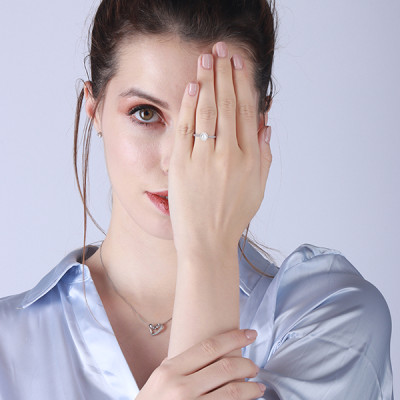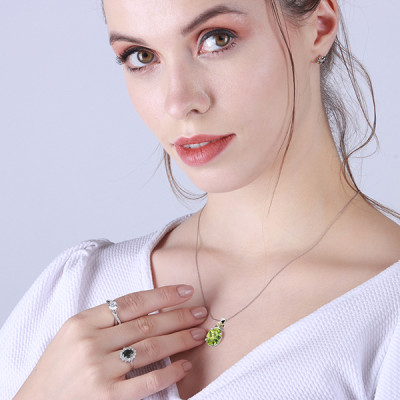SAPPHIRE GUIDE
(SEPTEMBER BIRTHSTONE)
The sapphire has long been associated with royalty and romance: it was the stone worn by kings and queens throughout history and continues to be popular in wedding rings today. It's also one of the few stones that can be found in almost every colour of the rainbow, making it an excellent choice for giving as a gift.
Sapphires are known for their symbolism as well. They are belived to symbolise fidelity and the soul amongst many other things. If you're looking for a gift that will make someone feel like royalty (or if you just want to treat yourself), consider giving them a beautiful sapphire ring or necklace! In this article, we look at the key features of the sapphire birthstone including its history, its characteristics and symbolism, how to choose a quality sapphire and how to look after a sapphire birthstone.

History of the Sapphire as the September Birthstone
Sapphire has been a popular gemstone ever since the ancient Greeks and Romans first began wearing it. In ancient Greece and Rome, the elite believed that blue sapphires protected their owners from harm and envy. This theme follows with clerics of the Middle Ages wearing sapphires because they believed the birthstones symbolised Heaven. Even the ancient Persians believed the earth rested on a giant sapphire, which made the sky blue.
Sapphires were historically found in Kashmir, Myanmar and Sri Lanka and this is where the majority of our sapphires are found today. They were first discovered in Kashmir in around 1881 after a landslide in the Himalayas uncovered a large quantity of them.

Characteristics of Sapphire
Sapphire is a hard-wearing gemstone and is highly valued for its beauty, strength, and durability. It's one of the hardest gemstones on earth, making it an excellent choice for all types of jewellery.
Sapphire is composed of aluminium oxide (Al2O3) with traces of other elements such as iron, titanium, chromium, vanadium, or magnesium. The colour of sapphire can vary from pure blue to yellowish orange to dark purple to black. Most sapphires are usually brightly coloured in many types of colours but blue is the most common.

Symbolism of Sapphire
The sapphire is the September birthstone and it has a rich history of symbolism throughout many cultures. The Greeks and Romans believed it to hold mystical powers that included wisdom, health, and purity. It was considered an amulet to ward off evil spirits and was thought to bring good luck and protect its wearer from harm. For centuries, they have been thought to attract divine favour and bring happiness to those who wear them. In ancient times, sapphires were worn by royalty to symbolize their power and authority over lesser people. They were thought to protect against witchcraft, sorcery and evil spirits.

How to Choose a Quality Sapphire
Whether you're looking for a ring, necklace or bracelet, sapphire jewellery designs are available in a variety of shapes and sizes. When choosing sapphire jewellery, it's important to consider the quality of the stone. Sapphires come in many different colours ranging from pale blue to deep blue-purple and pinkish red to yellowish orange. You don't want your stone to appear dull or cloudy. Ideally, it should have as few inclusions (tiny cracks) as possible and good clarity so that light reflects off its surface evenly.
Most people choose between oval cuts (which resemble an egg), round cuts with even edges on all sides and cushion cuts (which look like cushions). Princess Diana's famous sapphire engagement ring was a cushion cut stone with fourteen round diamonds set around it at different heights. Sapphire also pairs well with most other gemstones due to the various colours it's available in but especially with any gemstone with a blueish hue. It also pairs well with both silver and gold metals depending on the style you’re going for.
Sapphire Birthstone Care & Cleaning
Sapphires are often treated to improve their colour or clarity and therefore have to be looked after differently compared to untreated ones. Treated sapphires can be cleaned with warm soapy water and a soft brush. You should always avoid harsh detergents or solvents on all types of sapphire, as these could damage your stone's surface. Untreated sapphires are usually safe to clean in ultrasonic or steam cleaners used by jewellers.
When cleaning your sapphire, make sure it doesn't come loose from its setting, it's better to check it regularly than risk losing your stone. Sapphires should also be stored separately from other, softer gemstones as their hardness and durability can easily scratch soft gemstones.
Conclusion
In conclusion, sapphires have been treasured for thousands of years. They are among the most durable of gemstones and can be found in a wide range of colours. The deep blue hue of this stone is especially captivating, making it the perfect choice for September birthdays. Whether you choose a simple pendant or a more ornate design, sapphire jewellery will surely become an enduring keepsake that will add beauty to your life.
Faq
September's birthstone is sapphire. Sapphire is available in many colours and hues, including blue, green, purple, orange, yellow and pink.
The price of sapphires can vary from £50 per carat for a low-quality stone to over £10,000 per carat for a high-quality one. The most valuable sapphires are usually blue ones that are clear and transparent with fewer inclusions.
Sapphires are considered to be one of the most precious stones in the world. The price of sapphires has risen significantly over the past few years as demand has increased and supply has remained stable. The future of sapphire is likely to continue its price increase, as the demand for this gemstone continues to grow worldwide.
Sapphire is a type of corundum, which is a mineral that's the second hardest substance on earth. It's also considered to be one of the most durable gems.
Want to learn more about birthstone meanings? Check out our birthstone guides by month:
Browse All 12 Birthstone Guides
-

Garnet
January Birthstone -

Amethyst
February Birthstone -

Aquamarine
March Birthstone -

Diamond
April Birthstone -

Emerald
May Birthstone -

Pearl
June Birthstone -

Ruby
July Birthstone -

Peridot
August Birthstone -

Sapphire
September Birthstone -

Opal
October Birthstone -

Topaz
November Birthstone -

Tanzanite
December Birthstone

Article written by Nilesh
 Trustpilot
Trustpilot



